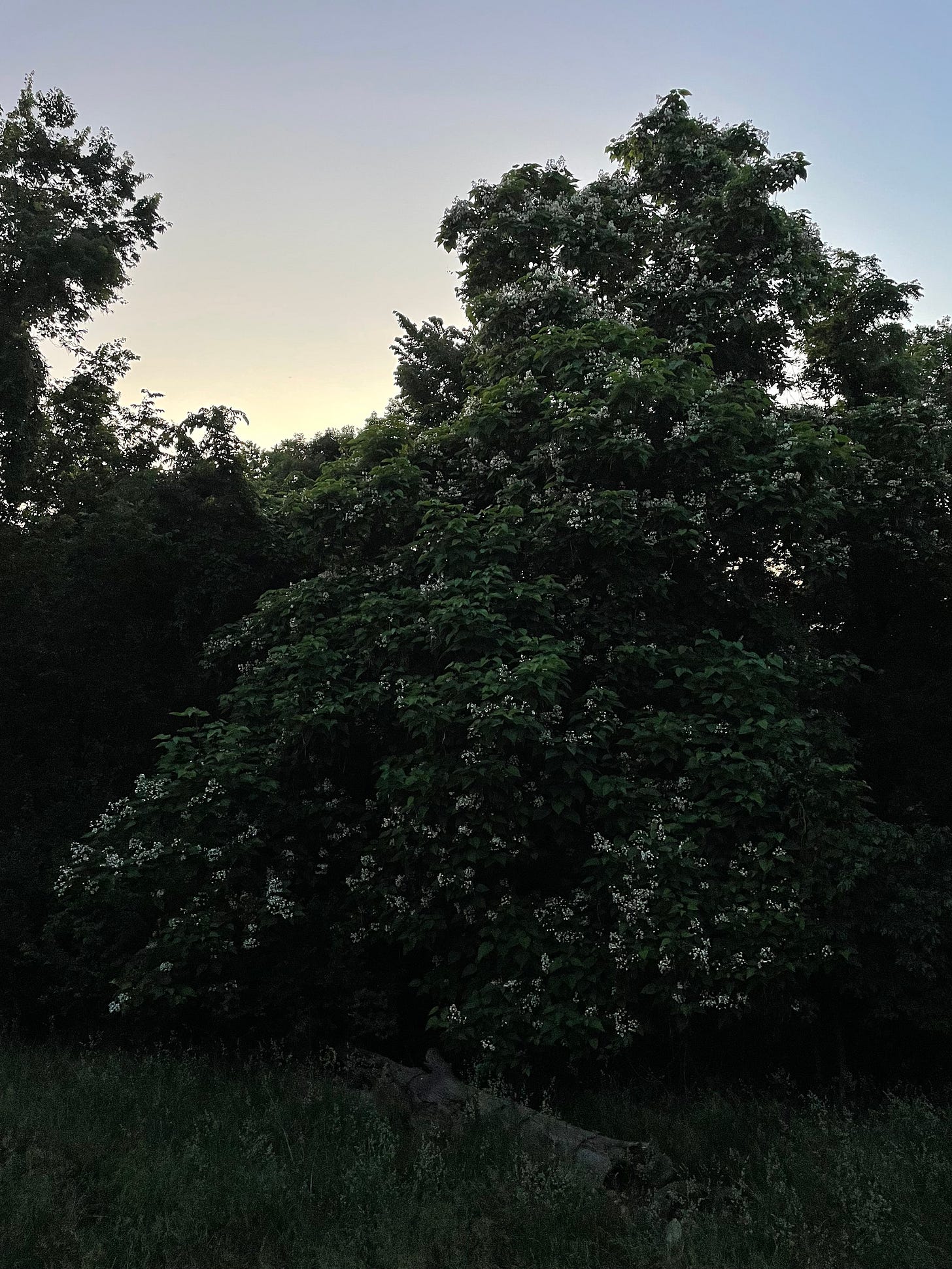Getting to Know the Natural World Around Us
Kids & Nature. Tree Trivia. Wild Edibles.
It’s taken me entirely too long to get to know the natural world around me. I shared this thought with my husband last night as we ate dinner in Hermann, Mo, overlooking the Missouri River. The flowing water at dusk was mesmerizing, and I thought about all the places it had traveled through before reaching us here. The stories it had collected. I notice this sort of beauty in nature often - bird songs floating through the garden at dusk, wildflowers dotting roadways, aged trees reaching to the sky. But until recently I hadn’t really taken the time to get to know the natural things that make up my every day. As a journalist I see story in everything - and I’m eager now to explore the stories of my own natural world. I want to know the names of the birds, the wildflowers, the trees; I want to know where they come from and why they are here. I want to know when I'm walking under a mulberry tree or past a paw paw tree, which weeds I should pull and toss and which ones I can instead toss in a salad.
My husband knows some of these things already. He was raised on forty acres in central Missouri, in a family whose roots and livelihood had for generations been in crop ground. Though he spent much of his time in nature, it wasn’t until he spent a season on the forestry team that a particular aspect of nature - trees - really caught his attention. He became familiar with each species they saw, getting to know them by name, leaf shape, bark texture, etc. For years now, when we’re strolling he’ll stop and quiz me: “what kind of tree is this?” And lately I’ve gotten better at answering - not just guessing - correctly. We closed our dinner conversation with the hope that we can foster this kind of curiosity and connection in our kids. We hope that they, too, will relish a relationship with nature. I see it happening already: they’re naming garden plants, pointing out woodpeckers, cardinals, and blue jays, and looking up to admire the trees. And befriending cicadas.
Gaby’s also working toward this goal as she pioneers a food forward approach to life and learning at Windsor Street Montessori School in Columbia. The school’s indoor/outdoor classroom space is primed for this: foodscaped herb beds, raised vegetable gardens and native plants give opportunity for new knowledge. You can follow along on the journey here. By encouraging kids to get their hands in the dirt, she’s fostering connections in the natural world, and then in the kitchen too. If we can do this for kids at such a young age, think of the opportunities that could blossom later in their lives! Connection to the earth, whether that’s to the place where we are rooted, or just where we’re standing, grounds us. It inspires us to seek beauty in meaning in the everyday. Because when you’re actively engaged with nature in this way, it really makes it so much more interesting to be alive, doesn’t it?
Good people + good food
Foodscaping your lawn
Foodscaping: the practice of integrating edibles into your ornamental landscape. Do you know this term? I became familiar with it just a few years ago, and now my front yard is home to a number of edible plants. This tasteMAKERs episode explores a St. Louis foodscaping business that specializes in shaping lawns and neighborhoods into places of plenty with permaculture. I love the mission behind this. From TasteMakers: In St. Louis, Matt Lebon of Custom Foodscaping builds permaculture food forests, focusing on native plants and resource management to create bountiful urban harvests. From restaurants to churches to schools, his food forests fulfill a range of needs, feeding bodies as well as spirits with his innovative edible landscape designs.
Wild edibles & the folks who find them
Bo Brown: I met Missouri forager Bo Brown during an interview for a Feast magazine story a few years ago. He’s the author of Foraging the Ozarks, a guidebook, and he’s the owner/operator of First Earth Wilderness School in southern Missouri. He’s all for fostering early relationships with nature, wild edibles in particular. “After all, we just need knowledge to preserve our traditions,” he says. Learn more about his story, in his own words, here.
Nadia Navarrete-Tindal: Nadia is a native plant specialist and an extension associate professor at Lincoln University in Jefferson City, Mo. She shepherds the FINCA Project - Families Integrating Nature, Conservation and Agriculture - at LU. I first learned about Nadia from Gaby, who has previously worked in partnership with her to plant native edibles at Windsor Street Montessori School. I met her recently at the Lincoln University Farmers Market, where she sold me a native Missouri passion fruit tree (which Bo Brown had taught me about years earlier). I took it home and will plant it in full sun in the rocky, eroded soil on the side of my house, where she said it’d do best. Here’s a Q&A with Nadia from the Missouri Prairie Foundation.
Gaby’s Summer Garden Focaccia
We’re into summer now, and Gaby shares her first round of summer garden focaccia in today’s #SundayFocaccia post. From Gaby: A slice of summer bliss... right in our own backyard! 🌼🍞️ Every Sunday, I harvest a slice of joy from our garden and bake a delicious Focaccia, infused with the freshest herbs and veggies. This week’s garden gems: dill, parsley, basil, garlic scapes, purple radish, and marigolds. 🌻 It’s moments like these that remind me of the beauty and bounty that surrounds us. I’m grateful for the chance to step outside and collect the fruits of our labor - literally! 🙏 Join me in appreciating the simple joys of garden-to-table living.
Take Me to the River - Getting to Know Missouri through the River Town podcast
I’m throwing out another link to River Town, the podcast I just wrapped up with KBIA and host Tina Casagrand Foss, founder and publisher of The New Territory magazine. Tina is one of the big reasons I have this newfound interest in building a better connection with nature. She cares deeply about place and people, so it makes sense that the episodes you’ll hear in this first season center around getting to know the Missouri River and how it shapes the people and places it flows through. Episode five is an especially beautiful example of this; student producer Tadeo Ruiz walks us through his newfound relationship with the Missouri River and the power of connection with the natural world.
That’s all for this week’s newsletter. Next week is #5! I consider this an early milestone. Let’s celebrate.







